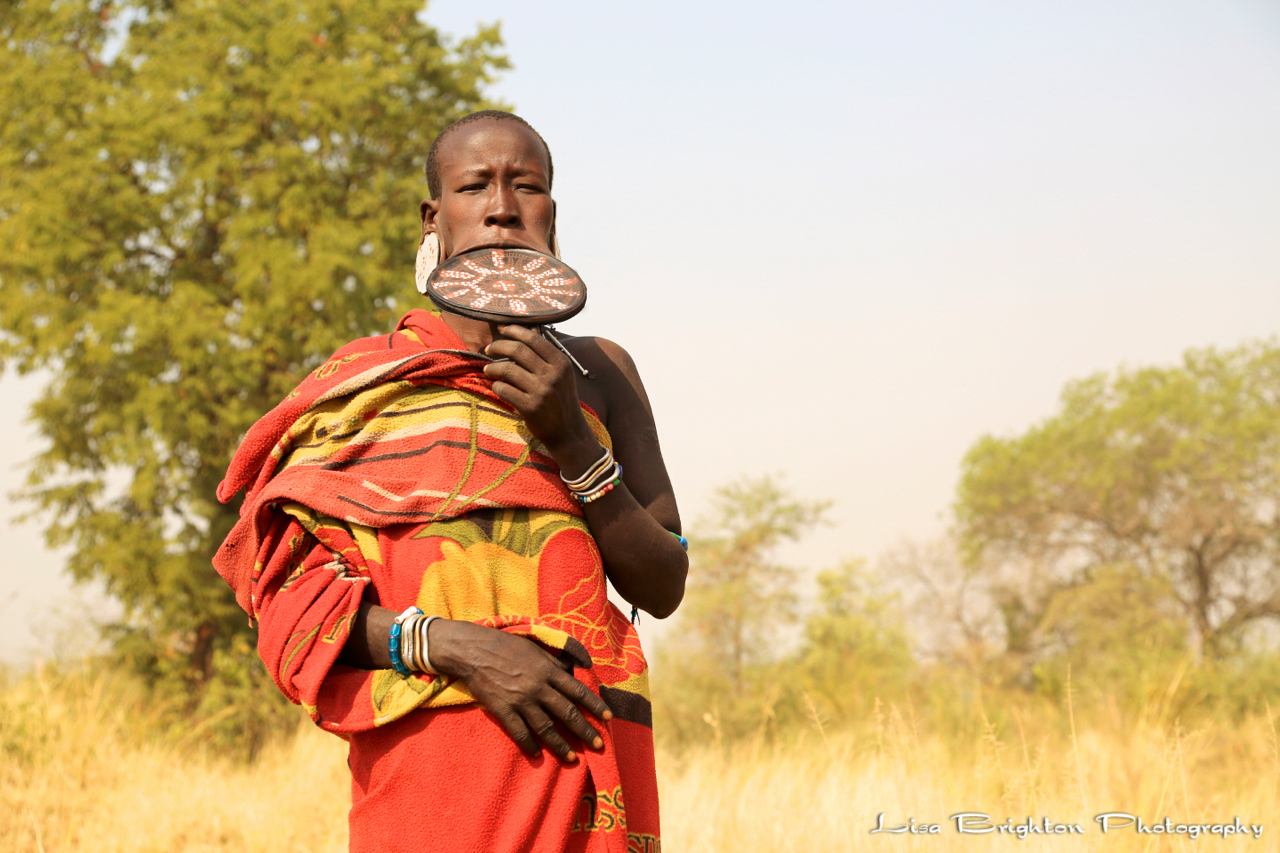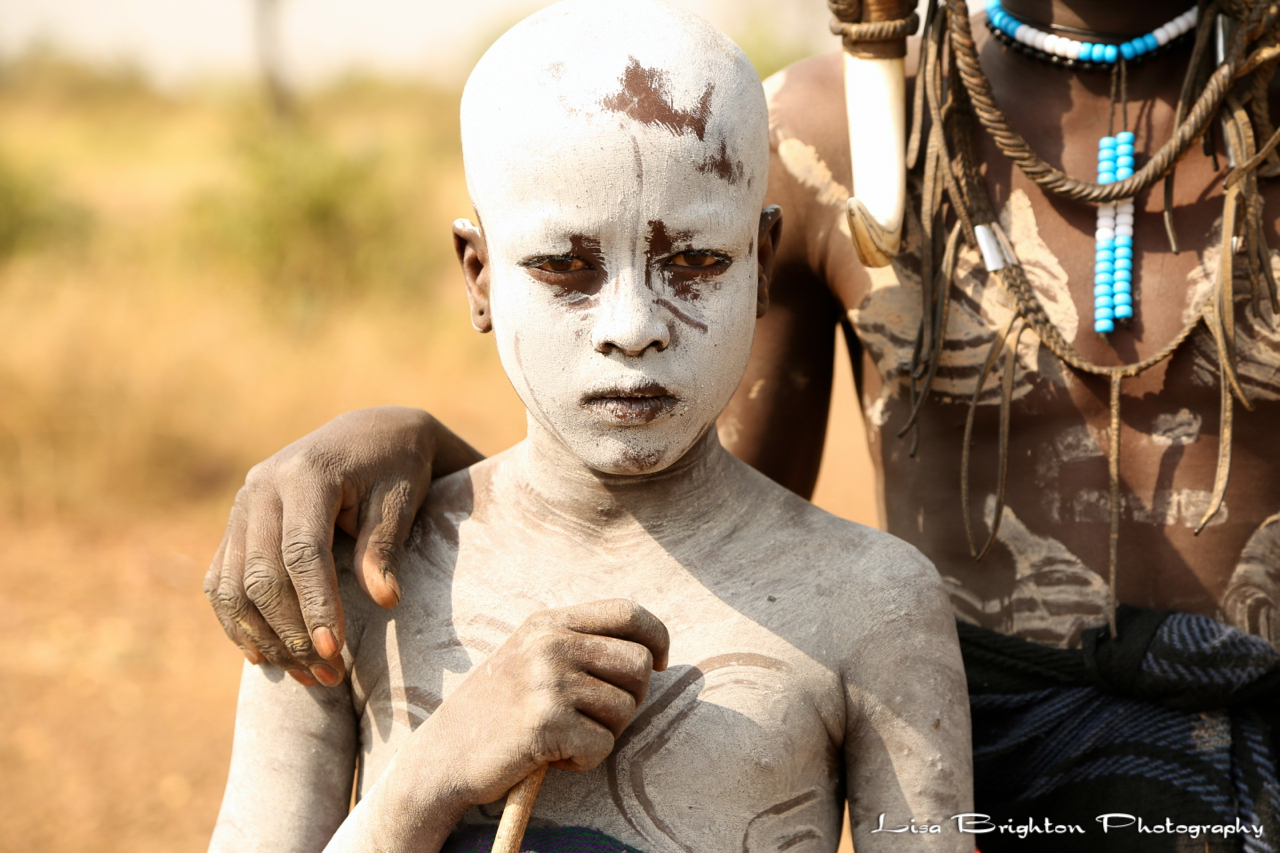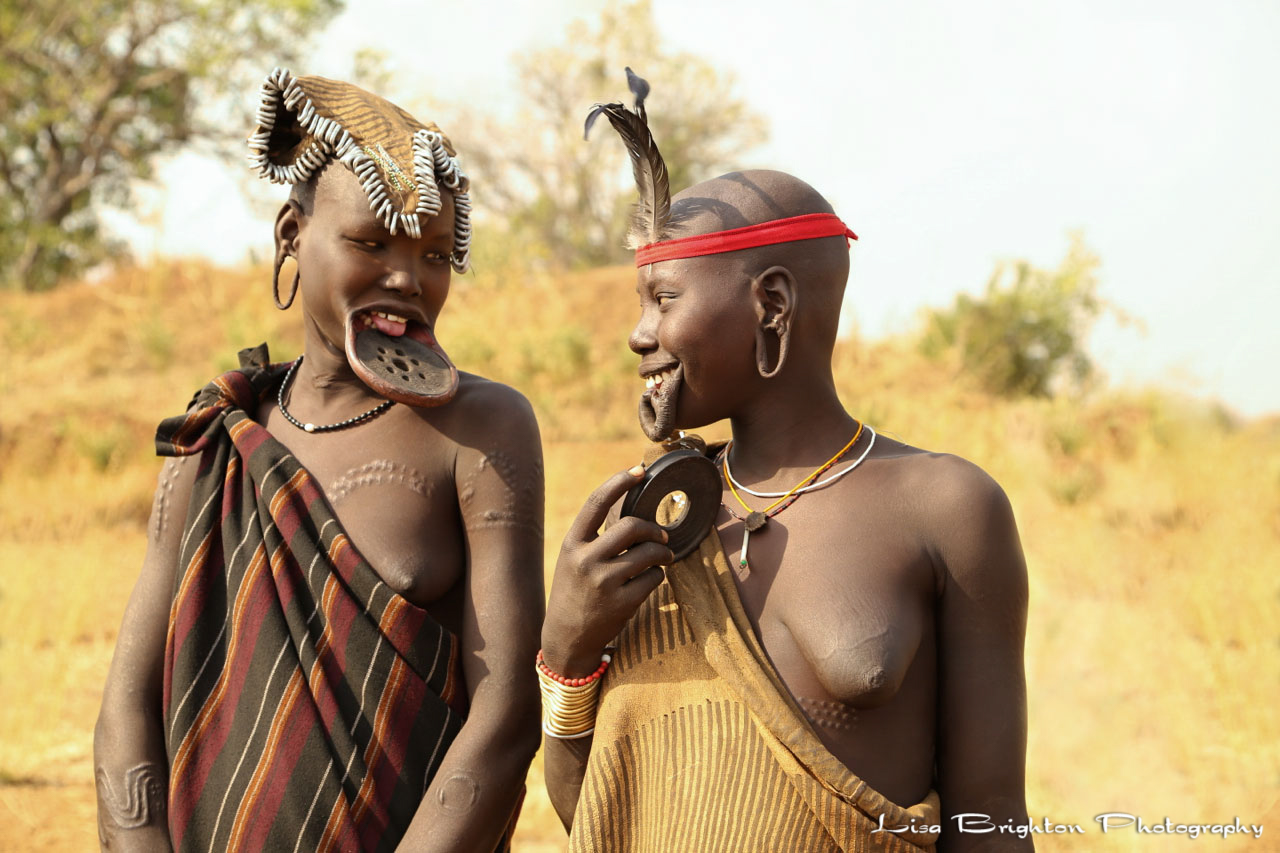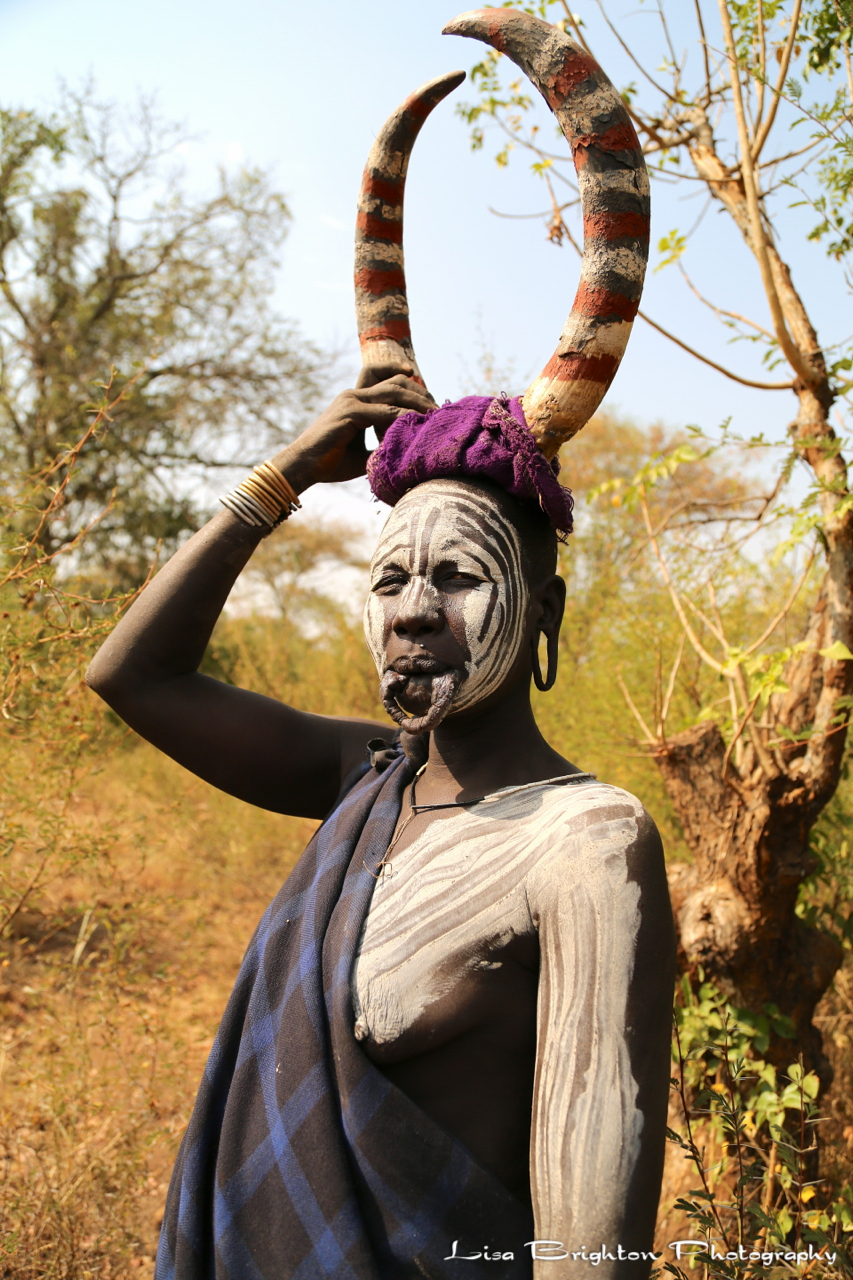2. Mursi
 “You have about 45 minutes to explore this village and take your images of the Mursi people,” someone from the National Geographic Photography Expedition team says. I look at my watch and think that’s not much time, given that it took me three flights, two days and a two-hour drive on a bumpy gravel road to get here. I also know that it took me many years of global travel and shooting to reach this point as an artist. I want to focus most of my work on women around the world, and looking around, I see many Mursi women whom I hope to photograph. With camera and excitement in tow, I break away from my group. I tell myself to stay focused because I’m almost immediately overwhelmed with how creatively the members of this tribe dress and adorn themselves. I knew I would be seeing a variety of lip plates, which are characteristic
“You have about 45 minutes to explore this village and take your images of the Mursi people,” someone from the National Geographic Photography Expedition team says. I look at my watch and think that’s not much time, given that it took me three flights, two days and a two-hour drive on a bumpy gravel road to get here. I also know that it took me many years of global travel and shooting to reach this point as an artist. I want to focus most of my work on women around the world, and looking around, I see many Mursi women whom I hope to photograph. With camera and excitement in tow, I break away from my group. I tell myself to stay focused because I’m almost immediately overwhelmed with how creatively the members of this tribe dress and adorn themselves. I knew I would be seeing a variety of lip plates, which are characteristic  of the women in this tribe, but I wasn’t expecting to see white paint on so many of their bodies. Many also wear embellished animal horns that are somehow staying upright on the tops of their heads. It feels surreal to be here. I go to work and ask one of the women if I can photograph her. She agrees, so we walk ahead to a wooded area that is a little more private, and she poses in front of my camera. As I’m photographing her, some other women and children start to gather. Before I know it, I’m surrounded by a group of people who all want their image taken, especially since they know they will be paid five Birr (Ethiopian currency) per shutter click. Earlier today, I was taught that the tribal people in the Omo Valley will silently count the audible “clicks,” and each person that steps before my lens does exactly that. It feels a bit odd to be taking images and paying them, but this is how the tribes in Ethiopia are adapting to a changing world and the invasion of tourism — they’re capitalizing on it. I check my watch and see that I have about fifteen minutes left. Then I notice some
of the women in this tribe, but I wasn’t expecting to see white paint on so many of their bodies. Many also wear embellished animal horns that are somehow staying upright on the tops of their heads. It feels surreal to be here. I go to work and ask one of the women if I can photograph her. She agrees, so we walk ahead to a wooded area that is a little more private, and she poses in front of my camera. As I’m photographing her, some other women and children start to gather. Before I know it, I’m surrounded by a group of people who all want their image taken, especially since they know they will be paid five Birr (Ethiopian currency) per shutter click. Earlier today, I was taught that the tribal people in the Omo Valley will silently count the audible “clicks,” and each person that steps before my lens does exactly that. It feels a bit odd to be taking images and paying them, but this is how the tribes in Ethiopia are adapting to a changing world and the invasion of tourism — they’re capitalizing on it. I check my watch and see that I have about fifteen minutes left. Then I notice some  other women joining the group. Unsure of how many images I can take before I run out of time, I remind myself to stay focused. I ask a woman holding a toddler if I can photograph her. She agrees and then points to her baby and to herself and holds up two fingers, meaning it’s going to cost twice as much. I nod my head and say, “I understand.” I take a few images, struggling to get one when they’re both looking at my lens. While I’m checking the photos on my LCD screen, I’m shocked to feel a hand grab my left breast then tightly squeeze and twist it. I quickly turn to my right and see a woman looking angrily at me, and I realize this is her way of getting my attention since she hasn’t been photographed. Stunned, I lean toward her and look deeply into her eyes while shaking my head “no,” and softly saying the word “no”. I try to convey my sadness as I
other women joining the group. Unsure of how many images I can take before I run out of time, I remind myself to stay focused. I ask a woman holding a toddler if I can photograph her. She agrees and then points to her baby and to herself and holds up two fingers, meaning it’s going to cost twice as much. I nod my head and say, “I understand.” I take a few images, struggling to get one when they’re both looking at my lens. While I’m checking the photos on my LCD screen, I’m shocked to feel a hand grab my left breast then tightly squeeze and twist it. I quickly turn to my right and see a woman looking angrily at me, and I realize this is her way of getting my attention since she hasn’t been photographed. Stunned, I lean toward her and look deeply into her eyes while shaking my head “no,” and softly saying the word “no”. I try to convey my sadness as I  put my hand on my heart and shake my head again. She seems confused, and I don’t know whether I’ve handled the situation appropriately. I think about finding my interpreter to further address what’s happened, but I don’t want to use my remaining photography time for that. Instead, I turn around and pay the woman with the toddler I just photographed. I then look to the rest of the group standing around me, purposely avoiding eye contact with the aggressive woman. I see a man holding a rifle, with a woman to his side. Making eye contact with him, I nod my head, and he moves to the area where the mother and child stood. The incident that just happened is still in my thoughts. I bring my camera to my eye while asking myself whether I’m being selfish by continuing as if nothing happened, though it actually was significant. The sound of the Land Rover’s horn honking immediately brings me out of my thoughts, and I know I have to go. As I pay the couple in front of me, those who were not photographed get restless and start saying things to me in a language I don’t understand. I briskly walk to the vehicle, aware that I’m being followed. This is not the way I envisioned my first day in the Omo Valley. However, this is their world that I’ve curiously stepped into. But that doesn’t explain why the aggressive woman thought it would be acceptable to hurt me. She unknowingly crossed a boundary I thought was universal among women. Although I can make all sorts of assumptions, I will never know why she did that. What I do know is that my exchange with her will haunt me for a very long time…
put my hand on my heart and shake my head again. She seems confused, and I don’t know whether I’ve handled the situation appropriately. I think about finding my interpreter to further address what’s happened, but I don’t want to use my remaining photography time for that. Instead, I turn around and pay the woman with the toddler I just photographed. I then look to the rest of the group standing around me, purposely avoiding eye contact with the aggressive woman. I see a man holding a rifle, with a woman to his side. Making eye contact with him, I nod my head, and he moves to the area where the mother and child stood. The incident that just happened is still in my thoughts. I bring my camera to my eye while asking myself whether I’m being selfish by continuing as if nothing happened, though it actually was significant. The sound of the Land Rover’s horn honking immediately brings me out of my thoughts, and I know I have to go. As I pay the couple in front of me, those who were not photographed get restless and start saying things to me in a language I don’t understand. I briskly walk to the vehicle, aware that I’m being followed. This is not the way I envisioned my first day in the Omo Valley. However, this is their world that I’ve curiously stepped into. But that doesn’t explain why the aggressive woman thought it would be acceptable to hurt me. She unknowingly crossed a boundary I thought was universal among women. Although I can make all sorts of assumptions, I will never know why she did that. What I do know is that my exchange with her will haunt me for a very long time…
